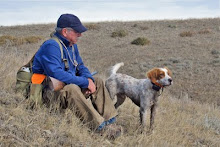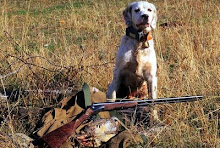Like I said last June, I wish I had known this method when I got my first
 dog. And he would probably have appreciated it, too. Unlike my younger dog who despite being started a little differently has since taken to the method, I find myself backtracking with my older dog in a way I wouldn't have needed to if I had understood and followed a method like this. For me at least, and I sense I am far from being the only one, I started seeing each step of training as a progressive sequence, rather than understanding the final goal and seeing how the first steps were a necessary part of that goal. I don't mind saying that I had no idea if I or my dog could get through a JH, let alone a SH, or a broke-dog stake. Each milestone was intialy an end rather than merely a milestone, a marker on the way from puppy to finished gun dog. The West method by necessity takes the long view: virtually every dog is capable of acquiring those skills if we, as trainers and handlers, don't get impatient, pay attention to each dog, and for the most part keep our mouths shut.
dog. And he would probably have appreciated it, too. Unlike my younger dog who despite being started a little differently has since taken to the method, I find myself backtracking with my older dog in a way I wouldn't have needed to if I had understood and followed a method like this. For me at least, and I sense I am far from being the only one, I started seeing each step of training as a progressive sequence, rather than understanding the final goal and seeing how the first steps were a necessary part of that goal. I don't mind saying that I had no idea if I or my dog could get through a JH, let alone a SH, or a broke-dog stake. Each milestone was intialy an end rather than merely a milestone, a marker on the way from puppy to finished gun dog. The West method by necessity takes the long view: virtually every dog is capable of acquiring those skills if we, as trainers and handlers, don't get impatient, pay attention to each dog, and for the most part keep our mouths shut.Punchline spoiler alert: this is a really useful book, especially if you have Dave's book, too. They complement and diverge from each other really nicely -- and assuming that most folks are familiar with the core of West method, I will simply pick out some parts of Training with Mo that I thought particularly useful. (For those of you looking for other resources on the West method, I encourage you to check out the Steady with Style website.)
Birds make a bird dog. While paying clients and their pros can often migrate to follow wild bird populations to let the dog learn from the bird, most of us amateurs can't. The challenge then becomes how to introduce young dogs to birds in a way that stimulates their drive and engages the genetics deep down in them, the genetics that will tell them when to stop chasing and slow down to a point. Mo, like Bill Gibbons out in AZ, uses carded pigeons and there's good information in here as to how to use them -- however, being a city dweller, I don't mind my dogs being interested in pigeons, but I don't want to reward them for pointing every single one. The more useful notes for me are on how Mo uses launchers to teach a variety of skills to dogs of intermediate and advanced status.
I think the sections on how Mo introduces intermediate dogs -- dogs which normally point, which have begun to understand the stop and stand still cue -- to pen-raised quail are thought provoking: why, for example, he will plant birds in the center of a thinly covered field; why he will try to have a helper to flush birds during early loose bird work; and how he introduces gunfire. I also found Mo's chapter on 'Problem Solving' to be interesting and useful -- through issues like blinking, circling, and flagging. My younger dog, for example, is pretty damned close to being broke, but somewhere in the last eight months, he began to flag on birds unless he can see them right in front of him or till you get in front of him to work them. It's not an uncertainty issue in terms of not trusting his nose and, heaven knows, I've beaten myself up enough trying to figure out what I did. Seeing Mo describe my exact scenario and ascribe a developmental phase to it is tremendously reassuring.
To paraphrase Mo, dog-training isn't (or shouldn't be) a race. For those of you interested in Mo's adaptation of the West method, Martha Greenlee's clearly written book is an easy read and a valuable perspective into developing a bird-dog over the long haul.









5 comments:
I've known Maurice for over 15 years and he's just what you'd want in a trainer. He trained my first bird dog and I watched the progression of his methods with pure fascination.
I haven't read the book yet so I'm not sure if it mentions that Maurice lost his hearing several years ago. I did a story on this for The Pointing Dog Journal (March/April 2002). It's amazing how he used this setback to re-focus on communicating with the dogs through body language. Training sessions now are very quiet affairs, no yelling and very little talking. He's an amazing guy, always willing to share his knowledge, completely devoted to his work, and I'm delighted to see him getting the recognition he deserves.
Mark:
Thanks for the comment. And yes, the book does mention Mo's lack of hearing and how he uses it to good effect. The general air of calm and quiet is frankly one of the things I appreciate about the West method, too.
best
Andrew
I just received mine earlier this week and I'm looking forward to reading it
Andrew, thanks for the informative review! A friend and fellow FTC officer is a friend of Maurice and has dogs bred and trained by him. He is constantly saying what a 'dog whisperer' Mo is.
I have the book on order.
I totally agree, I needed this book 35 yrs ago. I have never had the pleasure of meeeting Mo in person. I have enjoyed and learned a lot from him via email and chat rooms. Great guy and an excellent book.
Post a Comment